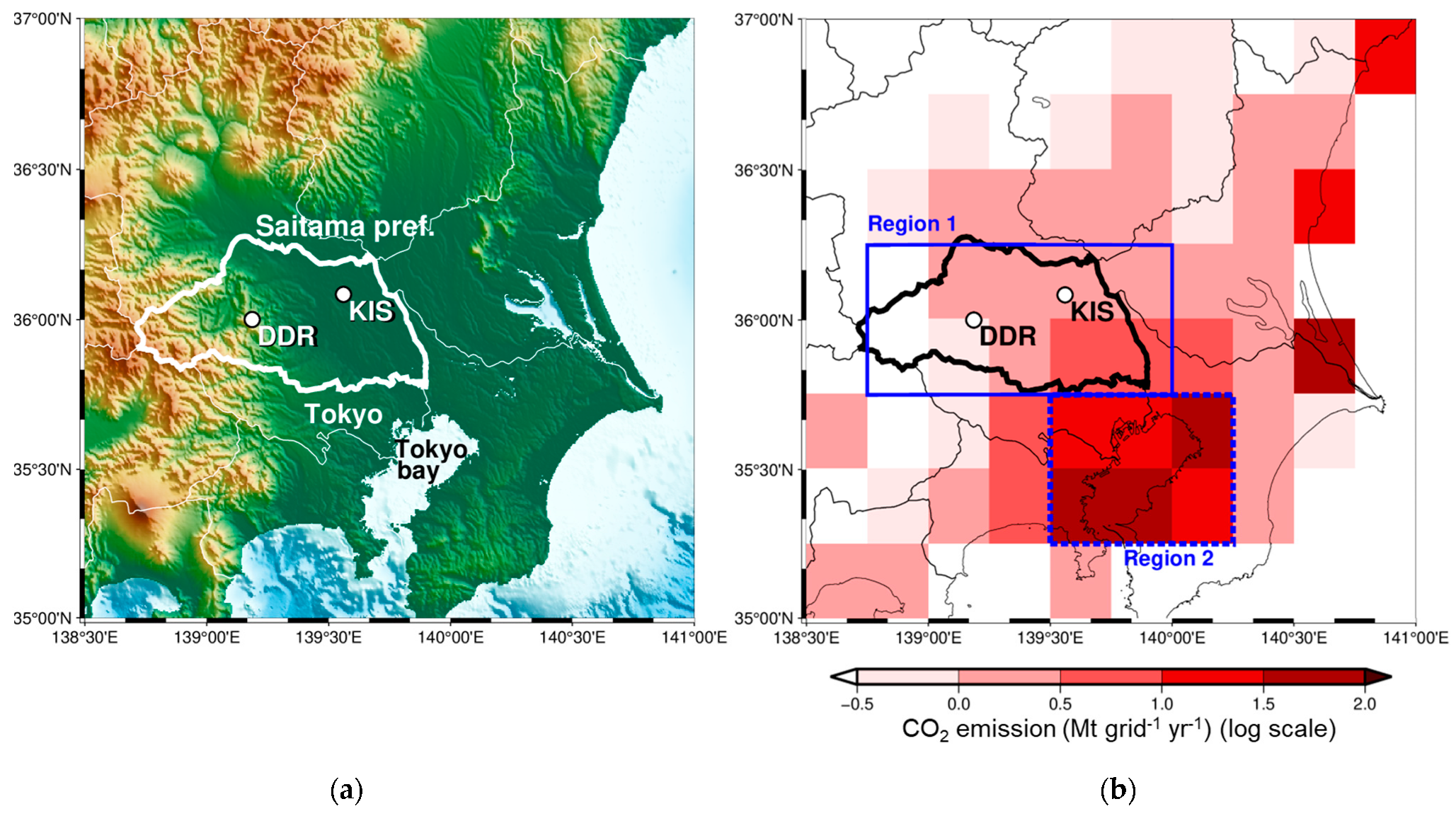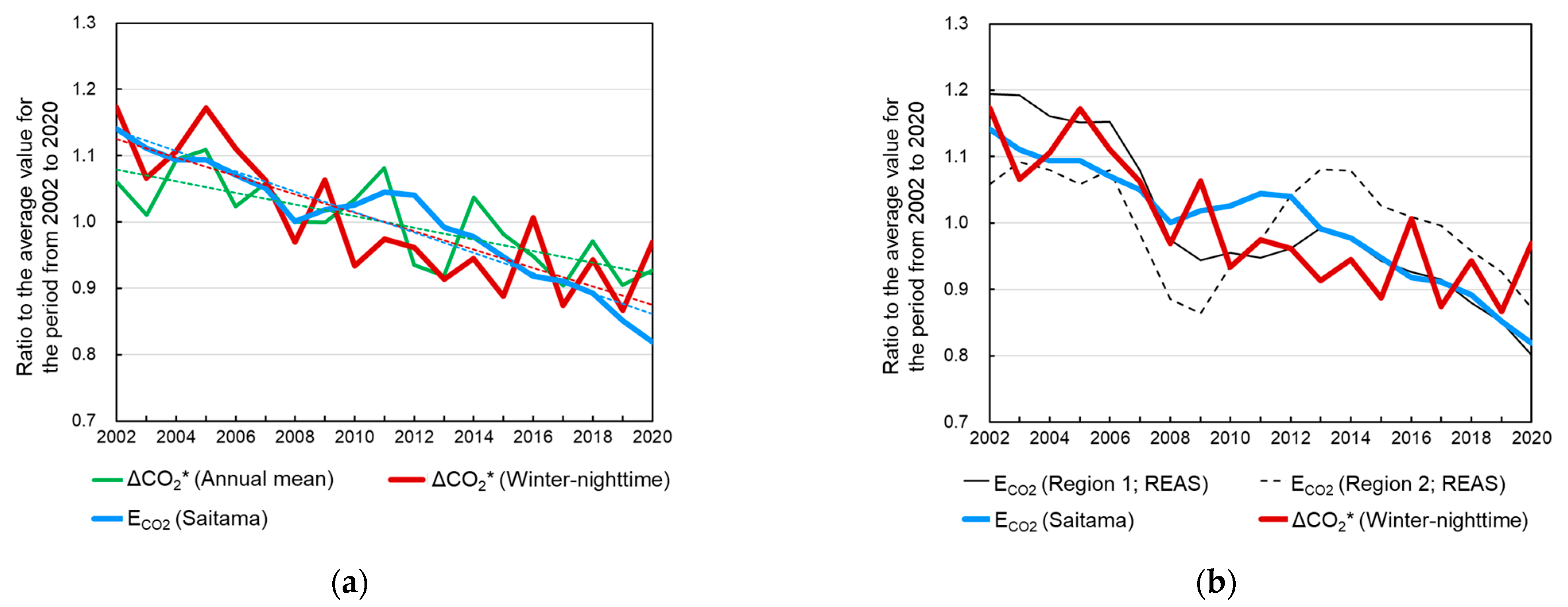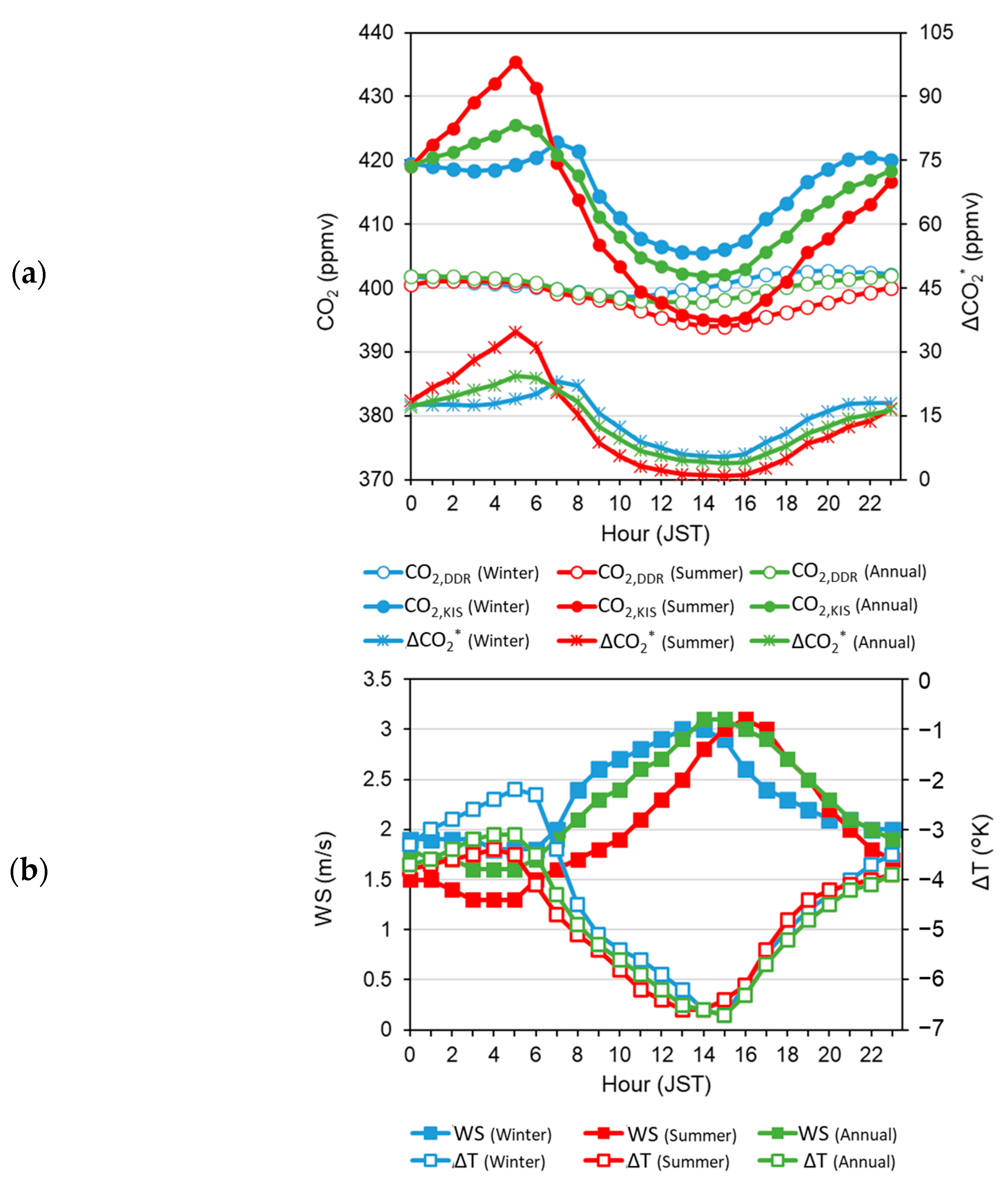Reduction in Anthropogenic CO2 Emissions Detected Through Two Decades of Observation in the Tokyo Metropolitan Area
Abstract
1. Introduction
2. Materials and Methods
2.1. Observed CO2 Concentration Data
2.2. Anthropogenic CO2 Emission Data
2.3. Analysis Methods
3. Results and Discussion
3.1. Long-Term Variations in CO2 Concentrations
3.2. Annual Trends in ΔCO2* and Anthropogenic CO2 Emissions
3.3. Relationship Between ΔCO2* and Meteorological Variables
4. Conclusions
Author Contributions
Funding
Institutional Review Board Statement
Informed Consent Statement
Data Availability Statement
Acknowledgments
Conflicts of Interest
References
- Gulev, S.K.; Thorne, P.W.; Ahn, J.; Dentener, F.J.; Domingues, C.M.; Gerland, S.; Gong, D.; Kaufman, D.S.; Nnamchi, H.C.; Quaas, J.; et al. In Climate Change 2021: The Physical Science Basis. In Contribution of Working Group I to the Sixth Assessment Report of the Intergovernmental Panel on Climate Change; Masson-Delmotte, V., Zhai, P., Pirani, A., Connors, S.L., Péan, C., Berger, S., Caud, N., Chen, Y., Goldfarb, L., Gomis, M.I., et al., Eds.; Cambridge University Press: Cambridge, UK; New York, NY, USA, 2021; Chapter 2; pp. 287–422. [Google Scholar]
- Lwasa, S.; Seto, K.C.; Bai, X.; Blanco, H.; Gurney, K.R.; Kılkış, S.; Lucon, O.; Murakami, J.; Pan, J.; Sharifi, A.; et al. Climate Change 2022: Mitigation of Climate Change. In Contribution of Working Group III to the Sixth Assessment Report of the Intergovernmental Panel on Climate Change; Urban systems and other settlements; Shukla, P.R., Skea, J., Slade, R., Al Khourdajie, A., van Diemen, R., McCollum, D., Pathak, M., Some, S., Vyas, P., Fradera, R., et al., Eds.; Cambridge University Press: Cambridge, UK; New York, NY, USA, 2022; Chapter 8. [Google Scholar]
- Gurney, K.R.; Liang, J.; Roest, G.; Song, Y.; Mueller, K.; Lauvaux, T. Under-reporting of greenhouse gas emissions in U.S. cities. Nat. Commun. 2021, 12, 53. [Google Scholar] [CrossRef]
- Wang, H.; Shi, W.; He, W.; Xue, H.; Zeng, W. Simulation of urban transport carbon dioxide emission reduction environment economic policy in China: An integrated approach using agent-based modelling and system dynamics. J. Clean. Prod. 2023, 392, 136221. [Google Scholar] [CrossRef]
- Labzovskii, L.D.; Mak, H.W.L.; Kenea, S.T.; Rhee, J.-S.; Lashkari, A.; Li, S.; Goo, T.-Y.; Oh, Y.-S.; Byun, Y.-H. What can we learn about effectiveness of carbon reduction policies from interannual variability of fossil fuel CO2 emissions in East Asia? Environ. Sci. Policy 2019, 96, 132–140. [Google Scholar] [CrossRef]
- Wang, G.; Peng, W.; Xiang, J.; Ning, L.; Yu, Y. Modelling spatiotemporal carbon dioxide emission at the urban scale based on DMSP-OLS and NPP-VIIRS data: A case study in China. Urban Clim. 2022, 46, 101326. [Google Scholar] [CrossRef]
- Zhu, X.-H.; Lu, K.-F.; Peng, Z.-R.; He, H.-D.; Xu, S.-Q. Spatiotemporal variations of carbon dioxide (CO2) at Urban neighborhood scale: Characterization of distribution patterns and contributions of emission sources. Sustain. Cities Soc. 2022, 78, 103646. [Google Scholar] [CrossRef]
- Shusterman, A.A.; Teige, V.E.; Turner, A.J.; Newman, C.; Kim, J.; Cohen, R.C. The BErkeley Atmospheric CO2 Observation Network: Initial evaluation. Atmos. Meas. Tech. 2016, 16, 13449–13463. [Google Scholar] [CrossRef]
- Verhulst, K.R.; Karion, A.; Kim, J.; Salameh, P.K.; Keeling, R.F.; Newman, S.; Miller, J.; Sloop, C.; Pongetti, T.; Rao, P.; et al. Carbon dioxide and methane measurements from the Los Angeles Megacity Carbon Project—Part 1: Calibration, urban enhancements, and uncertainty estimates. Atmos. Chem. Phys. 2017, 17, 8313–8341. [Google Scholar]
- Davis, K.J.; Deng, A.; Lauvaux, T.; Miles, N.L.; Richardson, S.J.; Sarmiento, D.P.; Gurney, K.R.; Hardesty, R.M.; Bonin, T.A.; Brewer, W.A.; et al. The Indianapolis Flux Experiment (INFLUX): A test-bed for developing urban greenhouse gas emission measurements. Elem. Sci. Anthr. 2017, 5, 21. [Google Scholar] [CrossRef]
- Karion, A.; Callahan, W.; Stock, M.; Prinzivalli, S.; Verhulst, K.R.; Kim, J.; Salameh, P.K.; Lopez-Coto, I.; Whetstone, J. Greenhouse gas observations from the Northeast Corridor tower network. Earth Syst. Sci. Data 2020, 12, 699–717. [Google Scholar] [CrossRef]
- Lian, J.; Lauvaux, T.; Utard, H.; Bréon, F.-M.; Broquet, G.; Ramonet, M.; Laurent, O.; Albarus, I.; Chariot, M.; Kotthaus, S.; et al. Can we use atmospheric CO2 measurements to verify emission trends reported by cities? Lessons from a 6-year atmospheric inversion over Paris. Atmos. Meas. Tech. 2023, 23, 8823–8835. [Google Scholar] [CrossRef]
- Sargent, M.; Barrera, Y.; Nehrkorn, T.; Hutyra, L.R.; Gately, C.K.; Jones, T.; McKain, K.; Sweeney, C.; Hegarty, J.; Hardiman, B.; et al. Anthropogenic and biogenic CO 2 fluxes in the Boston urban region. Proc. Natl. Acad. Sci. USA 2018, 115, 7491–7496. [Google Scholar] [CrossRef] [PubMed]
- Lauvaux, T.; Gurney, K.R.; Miles, N.L.; Davis, K.J.; Richardson, S.J.; Deng, A.; Nathan, B.J.; Oda, T.; Wang, J.A.; Hutyra, L.; et al. Policy-relevant assessment of urban CO2 emissions. Environ. Sci. Technol. 2020, 54, 10237–10245. [Google Scholar]
- Pisso, I.; Patra, P.; Takigawa, M.; Machida, T.; Matsueda, H.; Sawa, Y. Assessing Lagrangian inverse modelling of urban anthropogenic CO2 fluxes using in situ aircraft and ground-based measurements in the Tokyo area. Carbon Balance Manag. 2019, 14, 6. [Google Scholar] [CrossRef] [PubMed]
- Ohyama, H.; Frey, M.M.; Morino, I.; Shiomi, K.; Nishihashi, M.; Miyauchi, T.; Yamada, H.; Saito, M.; Wakasa, M.; Blumenstock, T.; et al. Anthropogenic CO2 emission estimates in the Tokyo metropolitan area from ground-based CO2 column observations. Atmos. Meas. Tech. 2023, 23, 15097–15119. [Google Scholar] [CrossRef]
- Kurokawa, J.; Ohara, T. Long-term historical trends in air pollutant emissions in Asia: Regional Emission inventory in ASia (REAS) version 3. Atmos. Meas. Tech. 2020, 20, 12761–12793. [Google Scholar] [CrossRef]
- National Greenhouse Gas Inventory Report of JAPAN 2023. Available online: https://cger.nies.go.jp/publications/report/i164/i164.pdf (accessed on 3 March 2025).
- Luqman, M.; Rayner, P.J.; Gurney, K.R. On the impact of urbanisation on CO2 emissions. Urban Sustain. 2023, 3, 6. [Google Scholar] [CrossRef]
- WMO WDCGG Data Summary, WDCGG No. 47, GAW Data, Volume IV-Greenhouse and Related Gases. Available online: https://gaw.kishou.go.jp/static/publications/summary/sum47/sum47.pdf (accessed on 3 March 2025).
- Imasu, R.; Tanabe, Y. Diurnal and seasonal variations of carbon dioxide (CO2) concentration in urban, suburban, and rural areas around Tokyo. Atmosphere 2018, 9, 367. [Google Scholar] [CrossRef]
- WMO Greenhouse Gas Bulletin, No. 19. Available online: https://library.wmo.int/idurl/4/68532 (accessed on 3 March 2025).
- Watanabe, F.; Uchino, O.; Joo, Y.; Aono, M.; Higashijima, K.; Yoshiaki, H.; Kazuhiro, T.; Kazuto, S. Interannual variation of growth rate of atmospheric carbon dioxide concentration observed at the JMA’s three monitoring stations: Large increase in concentration of atmospheric carbon dioxide in 1998. J. Meteor. Soc. Japan. 2000, 78, 673–682. [Google Scholar]
- WDCGG. Available online: https://gaw.kishou.go.jp/search/file/0065-2017-1001-01-01-9999 (accessed on 3 March 2025).
- WDCGG. Available online: https://gaw.kishou.go.jp/search/file/0065-2019-1001-01-01-9999 (accessed on 3 March 2025).
- Greenhouse Gas Emissions Report in Saitama Prefecture for the Fiscal Year 2022. Available online: https://www.pref.saitama.lg.jp/documents/25672/2022prefghgresult.pdf (accessed on 3 March 2025). (In Japanese).
- George, K.; Ziska, L.; Bunce, J.; Quebedeaux, B. Elevated atmospheric CO2 concentration and temperature across an urban–rural transect. Atmos. Environ. 2007, 41, 7654–7665. [Google Scholar] [CrossRef]
- Coutts, A.M.; Beringer, J.; Tapper, N.J. Characteristics influencing the variability of urban CO2 fluxes in Melbourne, Australia. Atmos. Environ. 2007, 41, 51–62. [Google Scholar] [CrossRef]
- Newman, S.; Xu, X.; Gurney, K.R.; Hsu, Y.K.; Li, K.F.; Jiang, X.; Keeling, R.; Feng, S.; O’Keefe, D.; Patarasuk, R.; et al. Toward consistency between trends in bottom-up CO2 emissions and top-down atmospheric measurements in the Los Angeles megacity. Atmos. Meas. Tech. 2016, 16, 3843–3863. [Google Scholar] [CrossRef]






Disclaimer/Publisher’s Note: The statements, opinions and data contained in all publications are solely those of the individual author(s) and contributor(s) and not of MDPI and/or the editor(s). MDPI and/or the editor(s) disclaim responsibility for any injury to people or property resulting from any ideas, methods, instructions or products referred to in the content. |
© 2025 by the authors. Licensee MDPI, Basel, Switzerland. This article is an open access article distributed under the terms and conditions of the Creative Commons Attribution (CC BY) license (https://creativecommons.org/licenses/by/4.0/).
Share and Cite
Ohara, T.; Muto, Y.; Kurokawa, J.; Shimada, T.; Uematsu, M. Reduction in Anthropogenic CO2 Emissions Detected Through Two Decades of Observation in the Tokyo Metropolitan Area. Atmosphere 2025, 16, 364. https://doi.org/10.3390/atmos16040364
Ohara T, Muto Y, Kurokawa J, Shimada T, Uematsu M. Reduction in Anthropogenic CO2 Emissions Detected Through Two Decades of Observation in the Tokyo Metropolitan Area. Atmosphere. 2025; 16(4):364. https://doi.org/10.3390/atmos16040364
Chicago/Turabian StyleOhara, Toshimasa, Yosuke Muto, Junichi Kurokawa, Tomohide Shimada, and Mitsuo Uematsu. 2025. "Reduction in Anthropogenic CO2 Emissions Detected Through Two Decades of Observation in the Tokyo Metropolitan Area" Atmosphere 16, no. 4: 364. https://doi.org/10.3390/atmos16040364
APA StyleOhara, T., Muto, Y., Kurokawa, J., Shimada, T., & Uematsu, M. (2025). Reduction in Anthropogenic CO2 Emissions Detected Through Two Decades of Observation in the Tokyo Metropolitan Area. Atmosphere, 16(4), 364. https://doi.org/10.3390/atmos16040364




